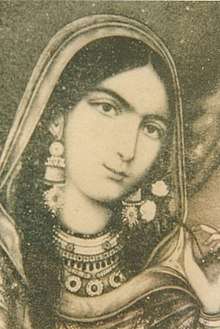Oudh State
The Oudh State (/ˈaʊd/,[1] also Kingdom of Oudh, or Awadh State) was a princely state in the Awadh region of North India until annexation by the British in 1856. Oudh, the now obsolete but once official English-language name of the state, also written historically as Oude, derived from the name of Ayodhya, its first capital.
British State of Oudh (1801–1858) Mughal Subah of Oudh (1732–1801) | |||||||||||
|---|---|---|---|---|---|---|---|---|---|---|---|
| 1732–1859 | |||||||||||
 Flag
 Coat of arms
| |||||||||||
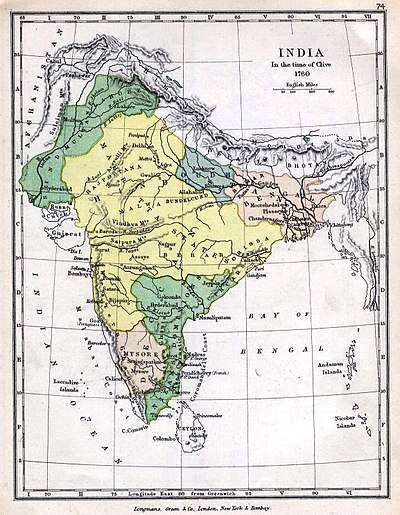 The Kingdom of Oudh in 1760 (Sapphire blue) | |||||||||||
| Status | Independent (1732–1801) Vassal of the East India Company (1801–1858) | ||||||||||
| Capital | Ayodhya Faizabad Lucknow | ||||||||||
| Common languages | Urdu | ||||||||||
| Religion | Shia Islam | ||||||||||
| Government | Mughal State (1732–1816) Princely State (1816–1858) | ||||||||||
| Nawab | |||||||||||
• 1722–1739 | Saadat Ali Khan I (first) | ||||||||||
• 1856 | Wajid Ali Shah (last) | ||||||||||
| History | |||||||||||
• Established | 1732 | ||||||||||
| 5 – 25 June 1858 | |||||||||||
• Oudh campaign | 3 Mar 1859 | ||||||||||
| Area | |||||||||||
| 62,072 km2 (23,966 sq mi) | |||||||||||
| Currency | rupee | ||||||||||
| |||||||||||
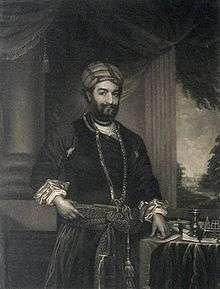
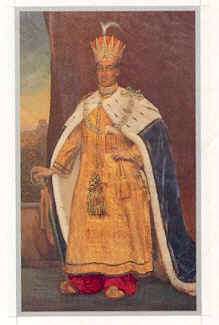
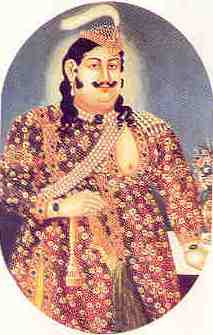
As the Mughal Empire declined and decentralized, local governors in Oudh began asserting greater autonomy, and eventually Oudh matured into an independent polity governing the fertile lands of the Central and Lower Doab. With the British East India Company entering Bengal and decisively defeating Oudh at the Battle of Buxar in 1764, Oudh fell into the British orbit.
The capital of Oudh was in Faizabad, but the British Agents, officially known as "residents", had their seat in Lucknow. The Nawab of Oudh, one of the richest princes, paid for and erected a Residency in Lucknow as a part of a wider programme of civic improvements.[2]
Oudh joined other Indian states in an upheaval against British rule in 1858 during one of the last series of actions in the Indian rebellion of 1857. In the course of this uprising detachments of the British Indian Army from the Bombay Presidency overcame the disunited collection of Indian states in a single rapid campaign. Determined rebels continued to wage sporadic guerrilla clashes until the spring of 1859. This rebellion is also historically known as the Oudh campaign.[3]
After the British annexation of Oudh by the Doctrine of Lapse, the North Western Provinces became the North Western Provinces and Oudh.[4]
History
Establishment
Saadat Ali Khan I was appointed Nawab of Oudh on 9 September 1722, succeeding Girdhar Bahadur. He immediately subdued the autonomous Shaikhzadas of Lucknow and Raja Mohan Singh of Tiloi, consolidating Oudh as a state. In 1728, Oudh further acquired Varanasi, Jaunpur and surrounding lands from the Mughal noble Rustam Ali Khan and established stable revenue collection in that province after quelling the chief of Azamgarh, Mahabat Khan.[5]:44 In 1739 Saadat Khan mobilized Oudh to defend against Nader Shah's invasion of India, ultimately being captured in the battle of Karnal. He attempted to cooperate with Nader Shah, but died at Delhi.
In 1740, his successor Safdar Jang moved the capital of the state from Ayodhya to Faizabad.[6] Safdar Jang gained recognition from Persia after paying tribute. He continued Saadat Khan's expansionist policy, promising military protection to Bengal in exchange for the forts at Rohtasgarh and Chunar, and annexing portions of Farrukhabad with Mughal military aid which was ruled by Muhammad Khan Bangash.
As regional officials asserted their autonomy in Bengal and the Deccan as well as with the rise of the Maratha Empire, the rulers of Oudh gradually affirmed their own sovereignty. Safdar Jang went as far as to control the ruler of Delhi, putting Ahmad Shah Bahadur on the Mughal throne with the cooperation of other Mughal nobility. In 1748 he gained the subah of Allahabad with Ahmad Shah's official support. This was arguably the zenith of Oudh's territorial span.[7]:132 [8]:193
The next nawab, Shuja-ud-Daula, further extended Oudh's control of the Mughal emperor. He was appointed vazir to Shah Alam II in 1762 and offered him asylum after his failed campaigns against the British in the Bengal War.[8]
British contact and control
Since Oudh was located in a prosperous region, the British East India Company soon took notice of the affluence in which the Nawabs of Oudh lived. Primarily, the British sought to protect the frontiers of Bengal and their lucrative trade there; only later did direct expansion occur.
Shuja-ud-Daula
British dominance was established at the Battle of Buxar of 1764, when the East India Company defeated the alliance between the nawab of Oudh Shuja-ud-Daula and the deposed nawab of Bengal Mir Kasim.[9]:25 The battle was a turning point for the once rising star of Oudh. The immediate effect was British occupation of the fort at Chunar and the cession of the provinces of Kora and Allahabad to Mughal ruler Shah Alam II under the Treaty of Benares (1765). Shaja-ud-Daula further had to pay 5 million rupees as an indemnity, which was paid off in one year.[10]:158[8]:252 The long-term result would be direct British interference in the internal state matters of Oudh, useful as a buffer state against the Marathas. The treaty also granted British traders special privileges and exemptions from many customs duties, which led to tensions as British monopolies were established.
Shuja-ud-Daula bought the Mughal provinces of Kora and Allahabad in Treaty of Benares (1773) with the British (who held de-facto control over the area) for 50 lakh rupees, increased cost of Company mercenaries, and military aid in the First Rohilla War to expand Oudh as a buffer state against Maratha interests.[9]:65[10]:75 Done by Warren Hastings, this move was unpopular among the rest of Company leadership, but Hastings continued a harsh policy on Oudh, justifying the military aid as a bid to strengthen Oudh's status as a buffer state against the Marathas. To shape the policy of Oudh and direct its internal affairs Hastings appointed the resident Nathaniel Middleton in Lucknow that year as well. At the conclusion of the First Rohilla War in 1774, Oudh gained the entirety of Rohilkhand and the Middle Doab region, only leaving the independent Rampur State as a Rohilla enclave.
Asaf-ud-Daula
Asaf-ud-Daula acceded to the nawabship of Oudh with British aid in exchange for the Treaty of Benares (1775) which further increased the cost of mercenaries and ceded the sarkars of Benares, Ghazipur, Chunar, and Jaunpur. From this time onwards Oudh was consistently compliant with the Company's demands, which continued to demand more land and economic control over the state.[11]
The Treaty of Chunar (1781) sought to reduce the number of British troops in Oudh's service to cut costs, but failed in this measure due to the instability of Asaf-ud-Daula's rule and thus his reliance on British aid essentially as a puppet regime.[12]
Later rulers
Saadat Ali Khan II acceded to throne of Oudh in 1798, owing his seat to British intervention including Governor-General of Bengal Sir John Shore's personal proclamation in Lucknow of his rule. A treaty signed on 21 February 1798 increased the subsidy paid to the British to 70 lakh rupees per year.[11]
In light of the Napoleonic Wars and British demands for greater revenue from the Company, in 1801, Saadat Ali Khan II ceded the entire Rohilkhand and Lower Doab as well as the sarkar of Gorakhpur under the pressure of Lord Wellesley to the British in lieu of the annual tribute.[13] The cession halved the size of the polity, reducing it to the original Mughal subah of Awadh (excepting Gorakhpur which was ceded) and surrounded it by directly-administered British territory, rendering it useless as a buffer. The treaty also mandated a government to be put in place that primarily served the citizens of Oudh. It was on the basis of the failure to meet this demand that the British later justified the annexation of Oudh.
Farrukhabad and Rampur were not annexed by the British yet; instead they served as separate princely states for the moment.[11]
The kingdom became a British protectorate in May 1816 (However, the state was an unofficial British protectorate since 1764, having little external autonomy). Three years later, in 1819, the Ghazi-ud-Din Haidar Shah took the title of padshah (king), signaling formal independence from the Mughal Empire under the advice of the Marquis of Hastings.
Throughout the early 1800s until annexation, several areas were gradually ceded to the British.
British annexation
On 7 February 1856 by order of Lord Dalhousie, General of the East India Company, the king of Oudh (Wajid Ali Shah) was deposed, and its kingdom was annexed to British India under the terms of the Doctrine of lapse on the grounds of alleged internal misrule.[14]
Between 5 July 1857 and 3 March 1858 there was an upheaval by the son of the deposed king joining the Indian Rebellion of 1857. At the time of the rebellion, the British lost control of the territory; they reestablished their rule over the next eighteen months, during which time there were massacres such as those that had occurred in the course of the Siege of Cawnpore.[15][16]
After Oudh's territory was merged with the North Western Provinces, it formed the larger province of North Western Provinces and Oudh. In 1902, the latter province was renamed the United Provinces of Agra and Oudh, and in 1904 the region within the new United Provinces, corresponding to the former North Western Provinces and Oudh, was renamed the Agra Province.[14]
Government
Feudatory states
The following were feudatory estates —taluqdaris[17] or parganas— of Oudh:
- Balrampur Estate[18]
- Benares State until 1775
- Bhadri Estate[19]
- Itaunja Estate[20]
- Nanpara Taluqdari[21]
- Pratapgarh Estate
- Tulsipur State
Rulers
The first ruler of Oudh State belonged to the Shia Muslim Sayyid Family and descended of Musa al-Kadhim originated from Nishapur. But the dynasty also belonged from the paternal line to the Kara Koyunlu through Qara Yusuf. They were renowned for their secularism and broad outlook.[22]
All rulers used the title of 'Nawab'.[23]
| Title | Reign Start | Reign End | Name |
|---|---|---|---|
| Subadar Nawab | 1732 | 19 Mar 1739 | Borhan al-Molk Mir Mohammad Amin Musawi Saʾadat ʾAli Khan I |
| 19 Mar 1739 | 28 Apr 1748 | Abu'l Mansur Mohammad Moqim Khan | |
| Nawab Wazir al-Mamalik | 28 Apr 1748 | 13 May 1753 | |
| Subadar Nawab | 5 Nov 1753 | 5 Oct 1754 | |
| 5 Oct 1754 | 15 Feb 1762 | Jalal ad-Din Shojaʾ ad-Dowla Haydar | |
| Nawab Wazir al-Mamalik | 15 Feb 1762 | 26 Jan 1775 | |
| 26 Jan 1775 | 21 Sep 1797 | Asaf ad-Dowla Amani | |
| 21 Sep 1797 | 21 Jan 1798 | Mirza Wazir ʾAli Khan | |
| 21 Jan 1798 | 11 Jul 1814 | Yamin ad-Dowla Nazem al-Molk Saʾadat ʾAli Khan II Bahadur | |
| 11 Jul 1814 | 19 Oct 1818 | Ghazi ad-Din Rafaʾat ad-Dowla Abul-Mozaffar Haydar Khan | |
| King (Padshah-e Awadh, Shah-e Zaman) | 19 Oct 1818 | 19 Oct 1827 | |
| 19 Oct 1827 | 7 Jul 1837 | Naser ad-Din Haydar Solayman Jah Shah | |
| 7 Jul 1837 | 17 May 1842 | Moʾin ad-Din Abu'l-Fath Mohammad ʾAli Shah | |
| 17 May 1842 | 13 Feb 1847 | Naser ad-Dowla Amjad ʾAli Thorayya Jah Shah | |
| 13 Feb 1847 | 7 Feb 1856 | Naser ad-Din ʾAbd al-Mansur Mohammad Wajed ʾAli Shah | |
| 5 Jul 1857 | 3 Mar 1858 | Berjis Qadr (in rebellion) |
Residents
| Name | Start | End |
|---|---|---|
| Nathaniel Middleton | 1773 | 1774 |
| John Bristow | 1774 | 1776 |
| Nathaniel Middleton | 1776 | 1779 (second time) |
| C. Purling | 1779 | 1780 |
| John Bristow | 1780 | 1781 (second time) |
| Nathaniel Middleton | 1781 | 1782 (third time) |
| John Bristow | 1782 | 1783 (third time) |
| William Palmer | 1783 | 1784 |
| Gabriel Harper | 1784 | 1785 |
| Edward Otto Ives | 1785 | 1794 |
| George Frederick Cherry | 1794 | 1796 |
| James Lumsden | 1796 | 1799 |
| William Scott | 1799 | 1804 |
| John Ulrich Collins | 1804 | 1807 |
| John Baillie | 1807 | 1815 |
| Richard Charles Strachey | 1815 | 1817 |
| John.R. Monckton | 1818 | 1820 |
| Felix Vincent Raper | 1820 | 1823 |
| Mordaunt Ricketts | 1823 | 1827 |
| Thomas Herbert Maddock | 1829 | 1831 |
| John Low | 1831 | 1842 |
| James Caulfield (interí) | 1839 | 1841 |
| William Nott | 1841 | 1843 |
| George Pollock | 1843 | 1844 |
| J. D. Shakespear | 1844 | 1845 |
| T. Reid Davidson | 1845 | 1847 |
| Archibald Richmond | 1847 | 1849 |
| Sir William Henry Sleeman | 1849 | 1854 |
| Sir James Outram | 1854 | 1856 |
Demographics
In the early eighteenth century, the population of Oudh was estimated to be 3 million. Oudh underwent a demographic shift in which Lucknow and Varanasi expanded to become metropolises of over 200,000 people over the course of the 18th century at the expense of Agra and Delhi. During this period the land on the banks of the Yamuna suffered frequent dry spells, while the Baiswara did not.[24]:38
Although it was ruled by Muslims, a majority, roughly four fifths, of Oudh's population were Hindus.[7]:155[25]
Culture
The Nawabs of Oudh were descended from a Sayyid line from Nishapur in Persia. They were Shia Muslims, and promoted Shia as the state religion.[12] Ghazi-ud-Din Haidar Shah instituted the Oudh Bequest, a system of fixed payments by the British paid to the Shia holy cities of Najaf and Karbala. These payments, along with lifelong stipends to the wives and mother of Ghazi-ud-Din served as interest on the Third Oudh Loan taken in 1825.[26]
The cities of Allahabad, Varanasi, and Ayodhya were important pilgrimage sites for followers of Hinduism and other Dharmic religions. The town of Bahraich was also revered by some Muslims.[27]
See also
References
- "Oudh – definition of Oudh in English from the Oxford dictionary". Archived from the original on 9 September 2015. Retrieved 1 September 2015.
- Davies, Philip, Splendours of the Raj: British Architecture in India, 1660–1947. New York: Penguin Books, 1987
- Michael Edwardes, Battles of the Indian Mutiny, Pan, 1963, ISBN 0-330-02524-4
- Ashutosh Joshi (1 January 2008). Town Planning Regeneration of Cities. New India Publishing. p. 237. ISBN 978-8189422820. Archived from the original on 3 March 2018. Retrieved 13 February 2016.
- Srivastava, Ashirbadi Lal (1933). The First Two Nawabs Of Oudh (a Critical Study Based On Original Sources). Lucknow: The Upper India Publishing House, Ltd.
- Sarvepalli Gopal (15 October 1993). Anatomy of a Confrontation: Ayodhya and the Rise of Communal Politics in India. Palgrave Macmillan. pp. 39–. ISBN 978-1-85649-050-4.
- Jaswant Lal, Mehta (2005). Advanced Study in the History of Modern India: 1707-1813. Sterling Publishers. ISBN 9781932705546.
- Markovits, Claude (ed) (2005). A History of Modern India 1480–1950 (Anthem South Asian Studies). Anthem Press. ISBN 1-84331-152-6.CS1 maint: extra text: authors list (link)
- Ramusack, Barbara N. (2004). The Indian Princes and their States. Cambridge University Press.
- Grover, B.L.; Mehta, Alka (2018). A New Look at Modern Indian History (From 1707 to the Modern Times) (32 ed.). S. Chand Publishing. ISBN 9789352534340.
- Habib, Irfan; Habib, Faiz (2014). "Mapping the Dismemberment of Awadh 1775-1801". Proceedings of the Indian History Congress. 75 (455–460).
- Davies, C. Collin (1960–2005). "Awadh". The Encyclopaedia of Islam, New Edition (12 vols.). Leiden: E. J. Brill.
- Treaty with the Nawab of Oudh for cession of Territory in commutation of Subsidy, concluded by Henry Wellesley and Lieut.-Col. William Scott 10th Nov. 1801
- Imperial Gazetteer of India vol. V 1908, p. 72
- Ben Cahoon. "Princely States of India – Oudh". Worldstatesmen.org. Archived from the original on 27 January 2013. Retrieved 8 August 2014.
- William Barton, The princes of India. Delhi 1983
- The Feudatory and zemindari India, Volume 17, Issue 2. 1937. Retrieved 4 August 2014.
- "Balrampur (Taluqdari)". Archived from the original on 4 March 2016. Retrieved 4 October 2015.
- "Bhadri (Taluq)". Archived from the original on 29 November 2013. Retrieved 4 October 2015.
- "Itaunja – Raipur Ekdaria (Taluq)". Archived from the original on 10 July 2015. Retrieved 4 October 2015.
- The Indian Year Book, Volume 29. Bennett, Coleman & Company. 1942. p. 1286. Retrieved 6 August 2014.
- Dr. B. S. Saxena (1974). "Repertoire On Wajid Ali Shah & Monuments of Avadh – Nawabs of Oudh & their Secularism". Avadh Cultural Club (Lucknow). Archived from the original on 27 August 2018. Retrieved 2 July 2014.
- Ben Cahoon. "List of rulers of Oudh". Worldstatesmen.org. Archived from the original on 27 January 2013. Retrieved 8 August 2014.
- Cole, J. R. I. (1989). Roots of North Indian Shīʾism in Iran and Iraq: Religion and State in Awadh, 1722-1859. Comparative Studies on Muslim Societies. University of California Press. ISBN 9780520056411.
- Defence Journal, Volume 5, Issues 2-4. p. 88.
On the contrary the annexation of Oudh in 1856 was viewed by the Muslim elite and the Hindu majority population of Oudh
- Litvak, Meir (February 2001). "Money, religion, and politics: The Oudh Bequest in Najaf and Karbala, 1850-1903". International Journal of Middle East Studies. 33 (1): 1–21.
- Surya Narain Singh (2003). The Kingdom of Awadh. Mittal Publications.
External links

- Heraldry of Oudh State
